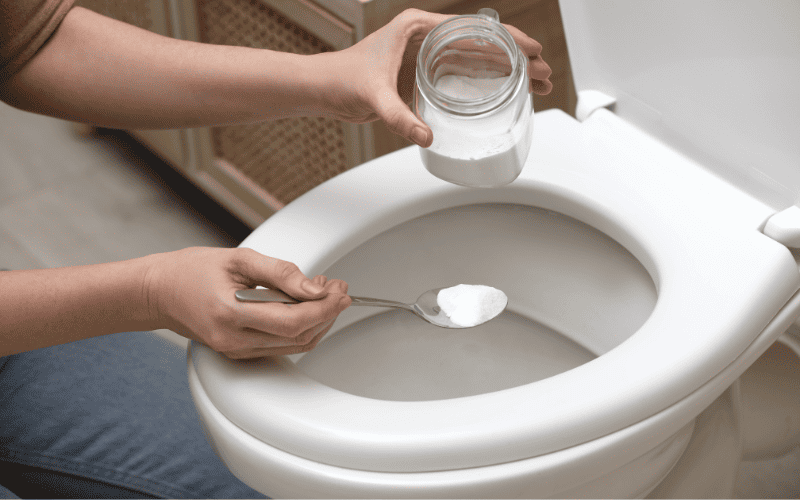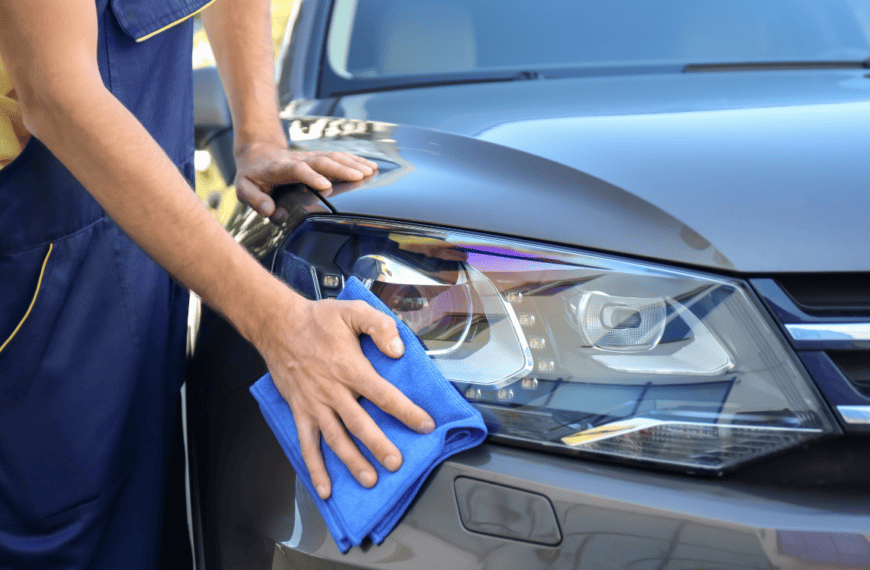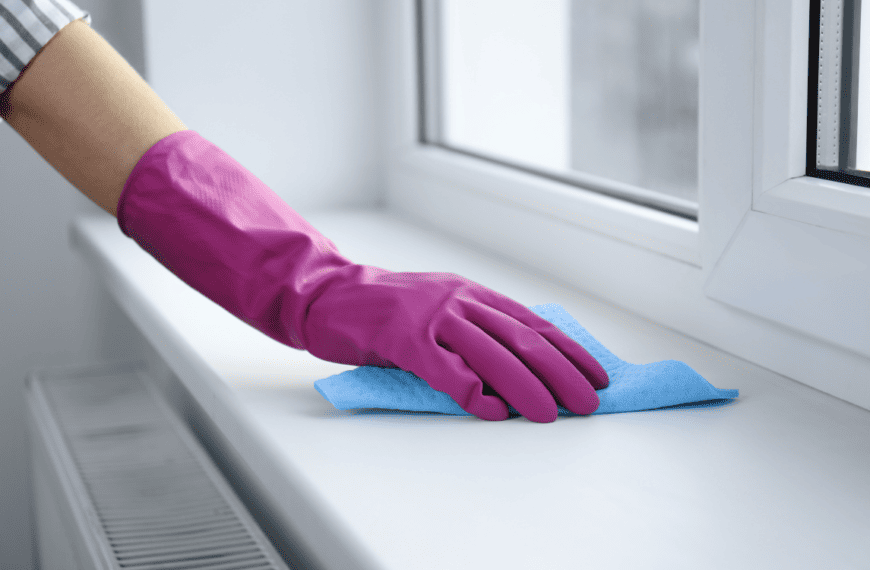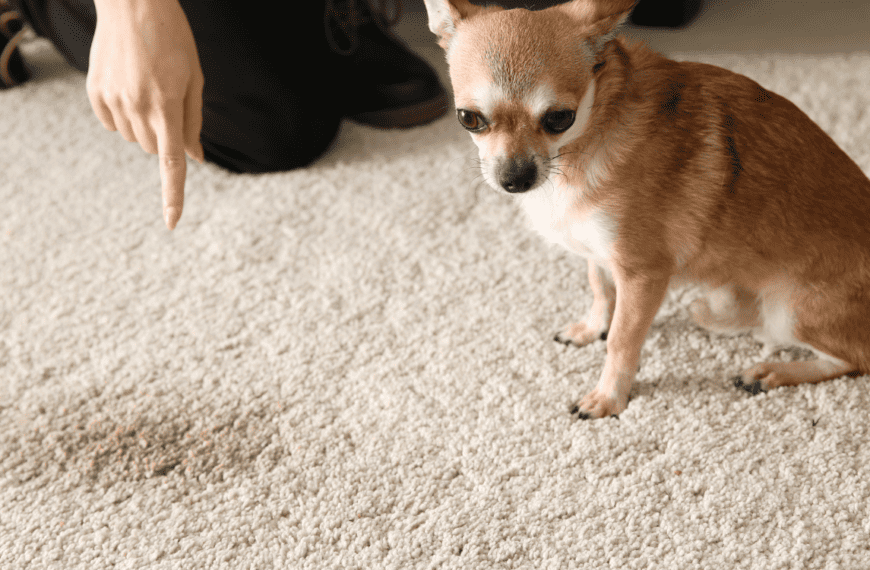The toilet bowl ring is not something that you have to deal with on a daily basis if you keep your toilet clean. However, sometimes going out of town for a few days or leaving that guest bathroom to sit can leave you with a stubborn toilet ring.
I’ll show you how to get rid of toilet ring and a method that I accidentally stumbled upon that has worked quite well.
How to Get Rid of Toilet Ring
To get rid of toilet bowl rings, flush the toilet and then sprinkle baking soda into the toilet bowl. Let the baking soda sit for a minute, and then pour in half a cup of vinegar. Use the toilet brush to mix the baking soda and vinegar and remove the toilet bowl stains. The vinegar and baking soda combination creates a potent cleaning solution that removes stubborn stains like a toilet ring.
What Causes Water Rings in Toilet?
It’s often thought that lack of cleaning with the trusty toilet brush is what causes toilet rings, but the real reason is quite different. Toilet rings are caused by hard water deposits, bacteria, and sometimes even mold.
The hard water deposits happen depending on where you live and the source of your water. Bacteria can happen from lack of cleaning, and mold is temperature-related and sometimes even airflow related (for example, keeping the toilet cover down all the time).
Types of Toilet Rings
The first time I found a toilet ring in my toilet bowls, it was in the guest bathroom that had not been used in a while. The ring was dark or black, making me nervous that the toilet was permanently stained.
It took a little elbow grease, some rubber gloves, and my baking-soda-white-vinegar method, but it did the trick. Here are the types of rings so you know what you are dealing with before you clean toilet bowl rings.
- Pink: pink toilet bowl rings are a result of bacteria in your toilet; when cleaning these, you may need to use more harsh chemicals to make sure that the bacteria is gone.
- Dark/Black (sometimes brown): dark or black and brown toilet bowl rings are from hard water and mineral deposits; if your toilet bowl water has the wrong composition, this will continue to happen.
- Yellow: yellow lines in the toilet bowl are from mold and mildew; you find this a lot in warmer climates and areas of the home where there is more moisture. In addition, some older toilets have this happen simply because the toilet itself is starting to deteriorate.
Methods To Remove Toilet Bowl Ring
The question I know you are dying to ask is whether or not you can just squirt a little toilet bowl cleaner in the toilet and call it a day. I understand the desire to do this, and you can certainly try, but it may not be enough to get your toilet bowl clean. Here are my best methods for removing stubborn toilet rings.
Baking Soda and Vinegar
My favorite solution, which I would go to first, is baking soda and vinegar. Luckily this one is eco-friendly and natural, and if you do it often enough, you may not even need to get your hands dirty!
- Flush the toilet and then pour about half a cup of baking soda into the bowl
- Let the baking soda stand for five minutes
- Pour in half a cup of white vinegar
- Mix the baking soda and vinegar and use the toilet brush to scrub them
- Flush the toilet and repeat if necessary
Pumice Stone (Best for Stubborn Stains)
When I don’t mind putting on gloves and reaching into the toilet, pumice stones are guaranteed to break up hard water stains and keep you from having to use a bleach solution in the toilet bowl.
- Get a pumice stone that has a handle specifically designed for cleaning toilet bowls.
- Complete submerging the pumice stone in water so that it softens just slightly.
- Work your way around the toilet bowl with the pumice to remove the toilet ring.
- Flush the toilet occasionally to see where you need to work on more difficult areas.
Abrasive Sponge
An abrasive sponge like the O-Cedar Scrunge is a good solution if you don’t want to scratch the toilet bowl (pumice stones can be harsh) but need to work on more difficult or stubborn stains. The problem with this solution is that you will likely have to prepare yourself with rubber gloves because you will be working inside the bowl.
- Open the tank of your toilet and lift the flapper so some of the water drains out and exposes the ring.
- Use the abrasive sponge to gently scrub the area where the nasty ring refuses to break down
- A spray bottle with vinegar can help; you can begin scrubbing and then spray a little vinegar on the area and continue.
- You may leave the vinegar spray on for 15 minutes and then come back and scrub again for the best results.
- When finished, flush the toilet, refill it with water, and close the tank.
Steel Wool
As much as you want to remove hard water stains and mold rings from your toilet, we also don’t want to damage the toilet. Make sure to get Grade #0000 steel wool, because it’s fine and won’t ruin your porcelain. If you are not hesitant or not sure, then go with other cleaning agents.
- Empty enough water out of the bowl to be able to expose the water line.
- Put a bit of baking soda on the steel wool.
- Lightly scrub the stains and then flush the toilet.
Bleach
Liquid chlorine bleach works well if your toilet rings are caused by mold or mildew in the toilet tank. Bleach is really strong, and you should make sure that you have open windows and plenty of ventilation in the bathroom when cleaning it.
Wear rubber gloves and watch out for your clothes so you don’t get irritated or ruin your clothing. Stay away from bleach if you have a septic system.
- Pour about ¼ cup of liquid bleach into your toilet bowl.
- Use the toilet brush to scrub the rings.
- Let the bleach sit for an hour if you want to remove toilet rings that have been there for some time.
- Flush the toilet and repeat if necessary.
- Pouring a little bleach in your toilet water before you go on vacation can help with stubborn stains from stagnant water
Vinegar and Borax
The vinegar and borax solution is almost exactly the same as the baking soda and distilled white vinegar solution.
- Flush the toilet and then sprinkle about ½ cup of borax into the water.
- Let the borax sit for twenty minutes.
- Pour a half cup of vinegar into the toilet bowl.
- Use a toilet cleaning brush to mix the two and scrub the ring.
- This more natural toilet cleaner solution will get rid of the toilet ring and keep your septic system safe.
Alka Seltzer (Better for Maintenance)
The Alka Seltzer tablet method is possibly the easiest on this list, but you may struggle if existing stains have been there for quite some time.
- Drop Alka Seltzer tablets into your toilet bowl.
- Let the tablets sit for 20 minutes.
- Come back and flush the toilet.
Denture Cleaning Tablets (Better for Maintenance)
I would love to know how this method was first discovered, but I imagine it had to do with someone accidentally dropping their denture cleaning tablets into the toilet bowl! This is another easy and quick method.
- Drop three denture cleaning tablets into the toilet bowl.
- Let the tablets sit for half an hour.
- Scrub the black ring with a toilet brush
- To remove stubborn stains, repeat the process a second time.
Hydrogen Peroxide (Better for Maintenance)
Hydrogen peroxide is a handy bathroom and kitchen cleaner. In addition, this one is safe for septic systems.
- Pour half a cup of hydrogen peroxide into your toilet bowl.
- Let this sit in the bowl for half an hour.
- Scrub the toilet bowl with a toilet brush.
- Flush and repeat as necessary
Chlorine Tablets (Better for Maintenance)
This is not a recommended method for people who have a septic system, and you have to make sure you are comfortable with chemicals as opposed to eco-friendly solutions. However, I have tried this, and it really works better for keeping a ring from forming, not when a stubborn ring has already formed.
- Take off the cover of the tank of your toilet.
- Drop a chlorine tablet into the water in the tank.
- Flush the toilet once
- Scrub with the toilet brush
- Keep the tablet in until it totally dissolves, and watch it work at removing the ring and preventing it
Dryer Sheets (Not Recommend)
Dryer sheets can work on shower doors and water spots, so I thought it might be worth it to try this on the ring in the toilet. I did not find dryer sheets to be particularly helpful, but here are the steps I took if you want to give it a try.
- Drain a little water from the toilet so the ring is exposed, and your dryer sheet won’t get submerged in the water.
- Put the dryer sheet on the end of the toilet brush and use it to scrub the toilet bowl ring
- This method can work ok when the stain is new and you don’t need something abrasive
Magic Eraser (Not Recommended)
The Mr. Clean Magic Eraser, contrary to popular internet cleaning hacks, does not contain any cleaning ingredients that can be released into the water to clean toilet bowls. It provides a mechanical clean, meaning it physically scrubs away dirt and grime, but does not have any chemicals that would be dispersed into the water when you flush. While it can effectively clean dirt around the toilet bowl and the exterior, it won’t prevent stains and rings inside the bowl. For a thorough clean, use a toilet bowl cleaner or antibacterial cleaner, a toilet brush, and rubber gloves.
Preventative Measures To Keep Toilet Bowl Ring Away
Now that you have a few different ways to remove toilet bowl rings, here are some things you can do to ensure they stay away for good.
- When going out of town, put a little bleach or vinegar in the bowl before you go; leave the toilet seat open so that the cleaning agent can do its job and moisture doesn’t get trapped.
- Set a schedule (at least twice per week) to clean your toilets and keep the stains away.
- From time to time, flush the toilet in bathrooms that are not getting used often. If you don’t have a septic system, leave a chlorine tablet in the tank
- Consider leaving a commercial cleaning agent in the toilet tank to help make cleaning easier on you.









